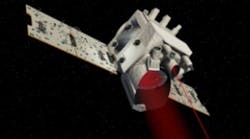Seed laser diodes from eagleyard Photonics (Berlin, Germany) are enabling SpaceTech GmbH/Immenstaad to build the Lidar Frequency Reference Unit for the German-French small-satellite mission MERLIN (Methane Remote Sensing Lidar Mission).
With a scheduled launch for 2021, the German-French satellite mission will measure methane gas concentration by means of a lidar instrument sending laser light pulses into the atmosphere, determining the gas concentration by the characteristics of the reflected light.
Lidar frequency-reference unit
eagleyard Photonics has been assigned by SpaceTech to deliver space-qualified distributed-feedback (DFB) seed laser diodes at 1064 nm and 1645 nm for the whole program, as well as for the corresponding qualification campaign, including the second generation of engineering models in 2017, the qualification models, and the flight models in 2018. SpaceTech is the responsible contractor for the frequency- reference unit of the lidar instrument for the entire mission program.
The decision to choose eagleyard as the supplier for the DFB seed laser diodes was based on eagleyard's successful international space references, including the successful ESA-GAIA mission as well as the NASA C.A.T.S. (Cloud Aerosol Transmission System) mission, both using eagleyard's 14-pin butterfly DFB laser diodes. In fact, the NASA C.A.T.S. mission is already operating a lidar instrument on board the International Space Station (ISS), seeded by an eagleyard laser diode.
eagleyard says it was also chosen for the capability of its quality division to autonomously run a space-related Lot Acceptance Test (LAT) campaign fully compliant with their customers' needs. Temperature-cycle tests, vibration and shock tests, radiation tests, and lifetime tests are part of a larger variety of harsh environmental test runs.
Its experience with the successful execution of such LAT campaigns, in which the company executed a careful balance between necessary quality assurance aspects within budget constraints, helped to make eagleyard a contributing member of ESA Photonics Working Group. This body defines and proposes useful guidelines for ESCC standards to qualify laser diodes in a meaningful way for space applications.
eagleyard will be at Laser World of Photonics 2017 (Munich, Germany; 26 to 29 June) in Hall B2 at booth #330.
Source: eagleyard Photonics

